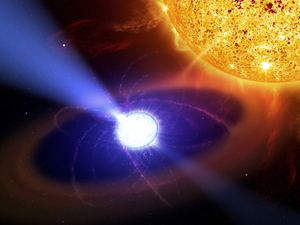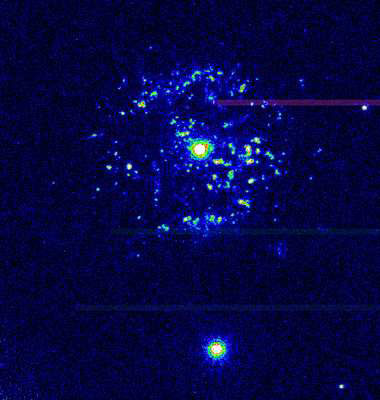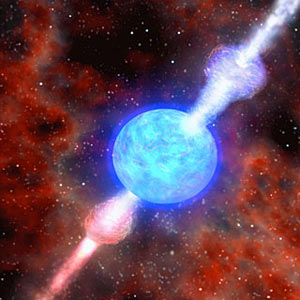As I mentioned in an earlier post, I attended the first few days of the American Astronomical Society meeting this week. I went as a member of the press, as I have for the past few years. The press room is a fun place; lots of old friends, banter across the table, and, of course, the press releases.
I had a stack in my mailbox, so I poked through them. One in particular caught my eye. And how could it not? In oversized, bold print the headline ran: “THE LONG OVERDUE RECURRENT NOVA T PYXIDIS: SOON TO BE A TYPE Ia SUPERNOVA?”
 Hmmm. Recurrent novae are binary systems, where a dense white dwarf is stealing matter from its companion. The matter piles up, and eventually detonates, causing a huge flash of light (that’s the nova part). After time, the system settles down, the matter starts piling up, and the cycle starts again (that’s the recurrent part). Lots of recurrent novae are known, and are fairly well understood.
Hmmm. Recurrent novae are binary systems, where a dense white dwarf is stealing matter from its companion. The matter piles up, and eventually detonates, causing a huge flash of light (that’s the nova part). After time, the system settles down, the matter starts piling up, and the cycle starts again (that’s the recurrent part). Lots of recurrent novae are known, and are fairly well understood.
T Pyxidis is a fairly regular nova, blowing its lid every 20 years or so. It’s currently overdue, since the last event was in 1967. Using ultraviolet observations and new models of the system, astronomer Edward Sion and his team concluded it may actually explode soon as a supernova, an event far more energetic than a mere nova. Worse, their models indicate the system is “much closer” than previously thought: about 3300 light years away. In the last paragraph of their press release, it says:
An interesting, if a bit scary, speculative sidelight is that if a Type Ia supernova explosion occurs within [that distance] of Earth, then the gamma radiation emitted by the supernova would fry the Earth, dumping as much gamma radiation (~100,000 erg/square centimeter) into our planet [sic], which is equivalent to the gamma ray input of 1000 solar flares simultaneously.
AIIIIEEEEE!!! We’re all gonna die!
 Hubble’s view of T Pyxidis from 1997, showing a shell of expanding matter from an earlier eruption.
Hubble’s view of T Pyxidis from 1997, showing a shell of expanding matter from an earlier eruption.
Ahem. Except, really, no. I rolled my eyes when I read that bit. A Type Ia does put out more high-energy radiation than a Type II supernova, which is caused when a massive star’s core collapses and the outer layers are ejected. That’s what most people think of when they hear about a supernova. Those have to be really close to hurt us, certainly closer than 25 light years. But even with their added power, a Type Ia just doesn’t have the oomph needed to destroy our ozone layer (as the press release indicates) from 3300 light years away. It would have to be far closer than that.
 I missed that press conference, but oh, how I wish I had been there! My friend Ian O’Neill was able to track down some details, and found out that astronomers (including another friend, Alex Filippenko, who is an expert’s expert on supernovae) at the meeting took Sion to task for this claim. It looks like Sion used the wrong numbers for the gamma ray emission for a Type Ia event, instead using the emission from a gamma-ray burst… a far, far, far more energetic event, and dangerous from several thousand light years away.
I missed that press conference, but oh, how I wish I had been there! My friend Ian O’Neill was able to track down some details, and found out that astronomers (including another friend, Alex Filippenko, who is an expert’s expert on supernovae) at the meeting took Sion to task for this claim. It looks like Sion used the wrong numbers for the gamma ray emission for a Type Ia event, instead using the emission from a gamma-ray burst… a far, far, far more energetic event, and dangerous from several thousand light years away.
I don’t generally have too big an issue with a scientist getting a number wrong, but it depends on the circumstance. Issuing a press release saying, essentially, we’re all gonna die means they should do some due diligence. And in this specific case – they used the phrase “fry the Earth” for Pete’s sake! – means I am less willing to cut them slack. People get scared from stuff like this, and it’s simply wrong to feed that fire without making really sure you have your numbers straight first.
I’ll note that scientists tend not to write press releases, and it can be hard to rein in the PR author if they are not that familiar with the science (which I’ve seen many times). But even if the numbers in the PR were correct, the phrasing of that last paragraph is unacceptable. Whoever wrote the release should have known the media would zero in on that phrase.
Ian O’Neil, in his post at Discovery News, points out The Daily Telegraph did just that, printing an article with the headline, “Earth ‘to be wiped out’ by supernova explosion”. The UK paper The Sun – which is so awful fish complain when you wrap them in it – had a similar article with the tagline, “A star primed to explode in a blast that could wipe out the Earth was revealed by astronomers yesterday.”
Sheesh.
It’s too bad. There was no need to disaster-porn this release up the way it was done. Recurrent novae and Type Ia supernovae are fascinating, well worth our attention for any number of reasons including of course their potential danger. But it’s a not-too-fine line between piquing interest and tarting up the science.
Artwork credits: Casey Reed, Dana Berry.